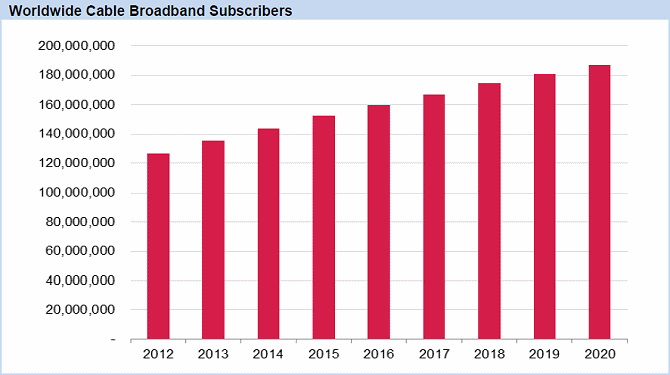Gigabit Cable DOCSIS Broadband Networks to Hold Ground vs FTTP
Amidst all the talk about deploying expensive ultrafast pure fibre optic (FTTP/H) networks, it’s easy to forget that Hybrid Fibre Coax (HFC) / DOCSIS based cable broadband networks (e.g. Virgin Media) are still holding their own and a new report from Ovum suggests that the future will be bright.
The report (HFC: Delivering Gigabit Broadband), which has been seen by ISPreview.co.uk, was seemingly commissioned by the National Broadband Network (nbn) in Australia, most likely to help make the case for their use of technology on that side of the world.
Advertisement
However the report also forecasts that cable networks, which use different variations of the Data Over Cable Service Interface Specification (DOCSIS) to deliver their services, will continue to grow by 4% each year for the remainder of the decade.

In fact worldwide cable broadband subscribers are forecast to increase from 152 million in 2015 to 187 million in 2020 (23% increase), which isn’t surprising because they’re cheaper to roll-out than pure fibre optic networks and often easier + quicker to upgrade.
As such HFC/Cable is forecast to retain a 19% share of the global broadband market between 2015-2020, while the European HFC/Cable broadband market will expand from 36 million to 42 million over 2015-2020 and this means it will maintain a European market share of 17% over 2015-2020.
Virgin Media’s own UK network has shown, using its EuroDOCSIS 3 technology, that it can deliver broadband speeds of up to 300Mbps. On top of that the imminent upgrade to DOCSIS 3.1, which Virgin’s parent Liberty Global would like to get underway by the end of 2016, could eventually push customer speeds into Gigabit (1000Mbps / 1Gbps) territory.
Advertisement
The new 3.1 standard can deliver peak (plant capacity) speeds of 10Gbps (Gigabits per second) by boosting the amount of radio spectrum available to it and making better use of Orthogonal Frequency Division Multiplexing (OFDM), although its asymmetric nature will initially keep upload performance limited to 1Gbps until the full-duplex upgrade arrives.

Naturally operator’s like Virgin won’t give domestic consumers access to Gigabit speeds via DOCSIS 3.1 right away and they’ll most likely continue a process of gradual speed boosting like they do today, but we could see 400-600Mbps packages cropping up in the not too distance future in order to best BT’s forthcoming 300-500Mbps G.fast technology; 1Gbps (download) would then follow a bit further down the road.
The report notes that over 20 global operators have already committed to launching DOCSIS 3.1, but it’s not always needed. Canadian operator, Rogers, says it will upgrade to Gigabit DOCSIS 3.0 (32×8 Hiltron modems) for an incremental in-year capital cost of “less than” US$50 per network premise (around £30).
Mind you most cable operators tend to be focused on urban areas, where it’s easier to reach a lot of premises in a short space of time and they’re an awful lot cheaper to serve. Likewise DOCSIS 3.1 doesn’t require lots of new cables to be built; it’s a fairly straightforward upgrade within the existing infrastructure.
Advertisement
Report Conclusions
Hybrid fibre-coax networks have evolved over the past seven decades and today remain highly competitive platforms offering market leading performance. This evolution is set to continue with increases in capacity supporting gigabit speeds both downstream and upstream on the horizon. For operators, the roadmap for further enhancements permits confidence that they will be able to continue to compete as investments in fibre (FTTP, FTTB and FTTN) challenge.
HFC is currently the leading broadband platform in the United States and is expected to retain a steady share of the global broadband market for the remainder of the decade. Ovum expects Cable broadband’s global market share to be stable at 19%, with a minor loss of share (from 56% to 54%) in the United States.
Network performance by HFC now rivals fibre platforms, with HFC operators enabling substantial increases in download speeds over the last five years. In the US average cable download speeds, as measured on behalf of the FCC, have improved from 12Mbps to 40Mbps. A similar improvement has been reported in the UK with cable speeds averaging over 70Mbps in November 2015.
These performance improvements are set to continue with global operators commencing the rollout of DOCSIS 3.1 across their networks this year. This step will enable the launch of gigabit speeds in many markets. The continued evolution of cable broadband is set to continue with the evaluation of full duplex techniques underway, a solution that will enable dramatic improvements in upstream capacity and speeds, ultimately allowing gigabit speeds both downstream and upstream.
Mind you it’s worth pointing out that some cable operators are expanding their network coverage and in doing so they’re seeing a greater potential to deploy pure Fibre-to-the-Premise (FTTP/H) lines too, which maintain compatibility with the DOCSIS standard and services by using Radio Frequency over Glass (RFoG) technology.
In that sense it may be wrong to view such markets as a simple case of HFC vs FTTP, with operators tending to be more dynamic in their approach than that. Virgin Media’s £3bn Project Lightning expansion aims to reach an extra 4 million UK premises by 2019 (c.60-65% UK coverage) and 1 million of those will be FTTP lines. This tends to occur in areas where the cost difference between rolling out new HFC or FTTP lines is very similar and thus FTTP is favoured, which is ultimately a more future proof technology.
A Virgin Media Spokesperson told ISPreview.co.uk:
“The future of our network is very much a blend of DOCSIS and FTTP connectivity.
DOCSIS has already helped put us ahead of our main competitors and the roll out of FTTP will be driven by the opportunities presented by network expansion, where our ambition is for one in four new premises passed to be using FTTP technology.”
A lot of the upgrade work that Virgin Media are doing now is also laying the ground work for a future DOCSIS 3.1 upgrade, although so far the operator has seemed reluctant to engage with us when we’ve asked about their related plans and timescale. Contrast that with BT, where they’ve been only too happy to talk about their G.fast approach. But it will come.
Mark is a professional technology writer, IT consultant and computer engineer from Dorset (England), he also founded ISPreview in 1999 and enjoys analysing the latest telecoms and broadband developments. Find me on X (Twitter), Mastodon, Facebook, BlueSky, Threads.net and Linkedin.
« First Customers Live on Bristol’s New 10Gbps Fibre Optic Network
BT Chairman Confirms Offer of Independent Openreach Board »

















































Comments are closed